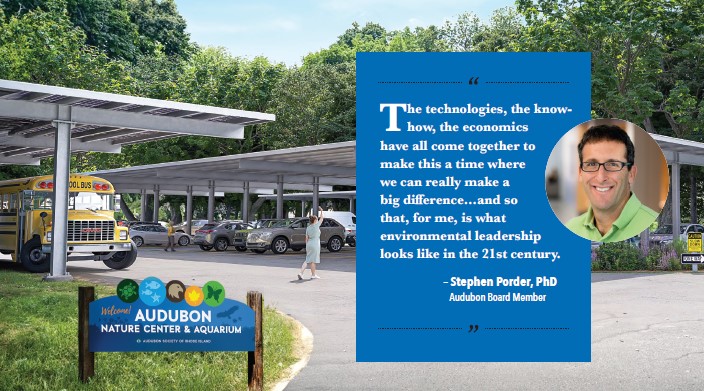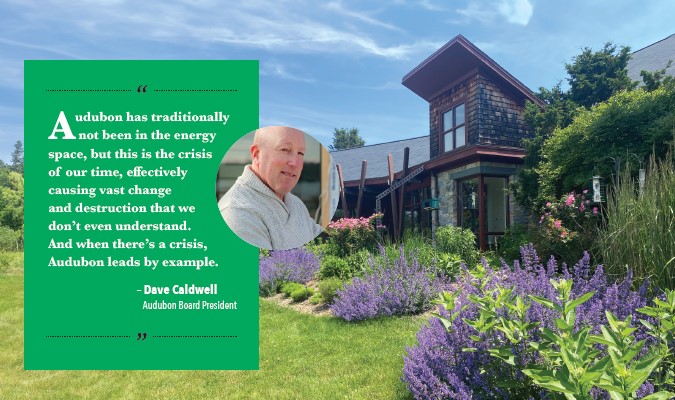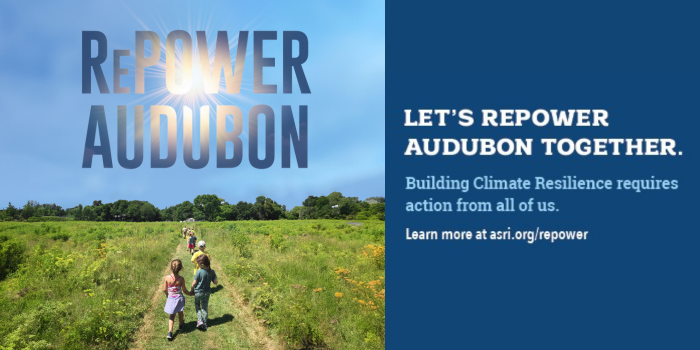
11 minute read
Audubon to Achieve True-Zero Emissions by 2040
By Sue Kennedy
RePower Audubon: Leading the Way to A Clean Energy Future
Audubon has seen first-hand how climate-induced weather events can wreak havoc on local wildlife refuges. The urgent, rising concern regarding climate and how to build resilience is something Audubon Executive Director Jeff Hall is very familiar with and sees as critical to our future. With strong support from the Audubon Board of Directors, Hall is guiding an Audubon initiative to take direct action by becoming one of the first nonprofit organizations in Rhode Island to eliminate its use of fossil fuels and thereby it’s greenhouse gas emissions. The organization will reach “net-zero” by 2030 by totally eliminating on-site fossil fuel use and adding solar power to its properties. By 2040, using advanced battery storage, Audubon will be emissions free 24 hours a day, 365 days a year.

Walking the Walk
To reach these ambitious goals, and “walk the walk” for birds, people, and the planet, Audubon has launched RePower Audubon this fall. This comprehensive campaign will enable the organization’s transition to clean energy and help us show others how to do the same.
“Our facilities, trucks, tractors, and grounds equipment will be fully electric by 2030. By that date, we will also have enough solar panels on our property roofs, carports and ground mounts to power the entire organization,” said Hall. “This is a critical step that will allow Audubon to reach ‘net-zero’ where we generate as much power as we use on all our properties.” Sitting at a table in his office, paging through energy reports, construction quotes and charts, his determination is evident. “By 2040, we will move beyond net-zero, using battery technology that stores the extra solar power we generate, so it can be used to power Audubon 24/7/365. At that point we won’t need to rely on a dirty electric grid – Audubon will reach ‘true-zero.’”
And as one of Rhode Island’s first non-profit organizations to pursue such a plan, “walking the walk” is a central component of the campaign, one that will allow Audubon to lead with integrity, says Hall. He is working to raise $4.25 million to replace aging, inefficient systems that heat and light Audubon facilities across the state. The campaign, with its commitment to renewables, features the renovations as an inviting and inspiring learning platform for its 17,000 members and supporters, the public, and other organizations.
Nature Doesn’t Have the Time to Wait
The data continue to roll in that document how climate impacts such as flooding and severe storms, continuing warming trends, and phenological mismatch* are changing and affecting the environment. Science, including Audubon’s research in Rhode Island, continues to show how birds eat, shelter, mate, raise young, and migrate in the face of climatic change. Data show our warming climate is disruptive to birds and to Rhode Island’s ecosystems. Nearly every group of birds, from those found in shrubby habitats and grasslands to those who eat insects on the fly are declining, and climate change is fueling the crisis.
At the same time, costly maintenance bills for upkeep of Audubon’s 14 facilities are also common items crossing Hall’s desk. The time is quickly approaching for replacement of much of the infrastructure, and in some buildings, it is centuries old. Hall says that the threat of climate change, combined with the need for upgrades, makes it the perfect time to change the way Audubon facilities are powered. In short, it’s time for Audubon infrastructure to move from being part of the problem to part of the solution.
And that’s where renewables come in. They create power without emitting carbon dioxide, the primary driver of human caused climate change, which is emitted when fossil fuels like oil and gas are burned. In contrast, renewables, including solar, wind and geothermal can be coupled with heat pumps to provide power and heat without emissions. Since the install costs of renewables and heat pumps can be high, it makes sense to couple them with end of life replacements of existing systems, and renewables are proving to be much more cost-efficient over time than traditional sources of heat and power. Audubon projects it will ultimately be able to save over $100,000 in energy costs annually - money that will be used to support conservation and education programming, rather than energy and maintenance bills.
Hall’s hope? He looks to build understanding about how, collectively, use of renewables can help temper the changes seen in the climate crisis. “RePower Audubon will help illuminate the connection between fossil fuels, a warming climate, and destabilized bird habitat,” he explains. “And become an example of what a brighter future can look like.” Stopping or slowing climate change will take many kinds of solutions, he indicates, but Audubon, as well as any home or business owner, can take steps to decrease their own footprints of damage and support environmental health. A benefit for humans and birds alike. “Climate science shows what we need to do,” he says. “To avoid the worst impacts of climate change, everyone must work to reduce the amount of planet-warming greenhouse gases produced, and the best way to do that is to make the transition to clean electric energy.”

Choosing a “Big, Bold Plan”
Transition became a central issue for Hall and Audubon’s Board of Directors, with staff and advisors regularly putting heads together to study and mull science-based options that could respond to the growing needs. Over time, a “big, bold plan” coalesced, says Hall, calling for a comprehensive, net-to-true-zero campaign and education program. Such a plan, in his estimation, wouldn’t have been possible without the board of directors, especially the unique expertise of Board President David Caldwell and Board Members Stephen Porder and Tina Duhaime.
Caldwell, a sustainable builder by trade, is widely recognized in Rhode Island for the balanced approach he brings to development projects and the emphasis he places on sustainable building practices. Ready and able to advise on both the construction and energy infrastructure aspects of the work, Caldwell, a board member for six years and president for the past two, also saw the project as a vital stage from which to educate people on two key aspects of sustainable building.
First, careful planning prior to construction is critical for ensuring a structure, be it a home or business, is matched to appropriate energy infrastructure systems -- doing so is one of the chief steps toward ensuring cost savings, regardless of the size of the effort. “You’ve got to plan,” he says. “Understand the incentives, understand the cost-versus-value propositions, and think about it before you’re in the emergency period.”
Second, says Caldwell, it behooves us all, when we build a structure these days, to try, as much as possible, to work some degree of renewable energy -- there are a wide variety of renovations that span the economic gamut -- into the project, as the environment may not be able much longer to accept the increasing brunt of the emissions burden from humans. “This is a global crisis, and the cause of it is burnt gas and oil,” says Caldwell of climate change. “Audubon has traditionally not been in the energy space, but this is the crisis of our time, effectively causing vast change and destruction that we don’t even understand. And when there’s a crisis, Audubon leads by example.”
Board member Stephen Porder, who is also a professor of ecology and Brown University’s Associate Provost for Sustainability, has advised Audubon for two years and echoes this commitment to action. High stakes, Porder indicates, call for Audubon to detour away from business-as-usual energy planning, as traditional approaches are largely inadequate to address the increasing impacts of climate change. And while Audubon’s going renewable does not equate to placing a dent in the world’s carbon dioxide emissions, Porder sees it as a significant step forward -- both in terms of reducing emissions and fostering community action. “There are an awful lot of people who work at Audubon, who come to Audubon, bring their kids to the Audubon Nature Center, who would like to do something less harmful, but don’t really know what that looks like.”
And the timing of the campaign couldn’t be better, as education is key. “The technologies, the know-how, the economics have all come together to make this a time where we can really make a big difference for every single person who walks into any Audubon facility in the State of Rhode Island,” says Porder. “And so that, for me, is what environmental leadership looks like in the 21st century.”
Something for Everyone
The RePower Audubon campaign offers something for everyone and has the potential to benefit many audiences and arenas beyond Audubon’s own. While Executive Director Hall recognizes the impossibility of any single person or entity being able to claim full credit for making environmental strides, he also says the scope of the campaign lifts the potential for key contributions to be made and celebrated.
He ticks off a list of these: cleaner water, healthier air, and more stable habitats. Fewer greenhouse gas emissions, energy independence, and stepping up to do our part to fix a global problem. “We all have a role to play,” he says.
That’s where the education program tied to the campaign comes in, with Audubon planning to coalesce community based activities for members, partners and the public around many of its RePower projects. A comprehensive slate of education events will allow the organization to not only engage people in experiencing the renovations as they take place but will open the door to dialogues about how they themselves can start thinking about progressive transitions to cleaner energy.
And as RePower Audubon gets underway, the organization encourages everyone to think creatively about how they would like to participate in the campaign and its activities, as well as the changes they would like to make in their own lives to foster a more climate resilient Rhode Island, one that’s as beneficial for people as it is for birds. “Every change is important, every single one of us can ask ‘what can I do, what role can I play?’” says Hall. “And in my view, there’s no better organization than Audubon to be a living model for this, and to help others learn to do it themselves.”
____
Sue Kennedy is a communications specialist for the URI Coastal Resources Center, serves on the Warwick Wildlife & Conservation Commission, and enjoys freelancing; reach her at skennedy1168@gmail.com.

THE ROADMAP TO REPOWER AUDUBON
1. Update plumbing, electrical, and heating systems that will make Audubon facilities more energy efficient and save thousands of dollars a year. Completion: 2027
2. Install heat pumps that run on electricity, rather than natural gas, propane, or oil, and to reduce our greenhouse gas emissions. Completion: 2028
3. Generate the amount of energy used by the organization by adding ground and roofmounted solar arrays and two parking lot solar canopies. Completion: 2029
4. Spread the word about the benefits of clean energy to Audubon members, visitors, and the public through signage, education programs, and focused workshops for nonprofit and small business leaders interested in going net-zero. Completion: 2040
5. Invest in battery storage after 2030 to use only our own generated power and meet the goal of true-zero emissions by 2040. Completion: 2040
6. Raise $4.25 million. By reaching our 2040 goal, we will do everything we can to speed Rhode Island’s transition to total emissions–free electricity, and build out our own capacity to achieve this goal on-site as needed. Completion: Now!
The bulk of the work – the heat pumps, solar canopies, and system upgrades will take place in fewer than six years. The replacement of the fossil fuel HVAC system at the Nature Center and Aquarium in Bristol has already started this fall; the system will be replaced with an all-electric air sourced heat pump. Heat pumps alone may well reduce Audubon’s greenhouse gas emissions by as much as 64 percent yearly.
As each portion of work is carried out, and the new efficient systems come online, savings will begin to accrue and will help offset installation and related construction costs. The money Audubon saves on energy costs can power our central mission to protect birds through science, conservation, education, and advocacy.










